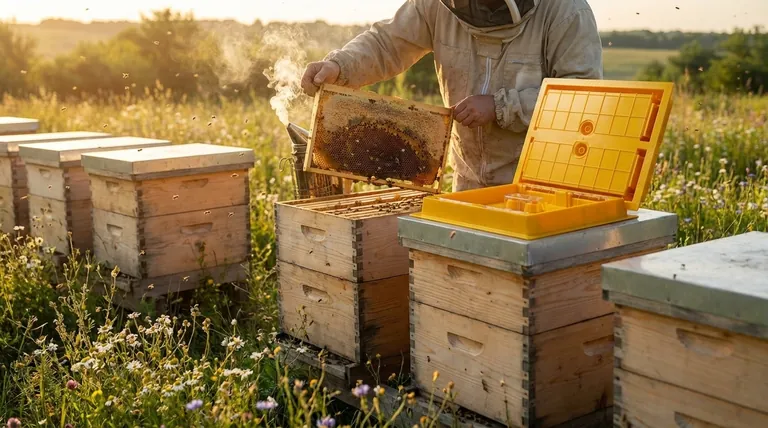At its core, the Langstroth hive is overwhelmingly popular for three key reasons. It is a standardized, modular system that makes beekeeping more efficient and accessible. Its design simplifies hive inspections, management, and honey harvesting, and its global prevalence means equipment and educational resources are abundant.
The true advantage of the Langstroth hive is not just the box itself, but the entire system built around it. Its universal standardization empowers beekeepers by providing unmatched flexibility, a wealth of resources, and a clear, proven path for managing a colony.

The Foundation of Modern Beekeeping: Standardization
The single greatest advantage of the Langstroth design is its status as a global standard. This has profound implications for every beekeeper who uses one.
Universally Available Equipment
Because the dimensions are standardized, components are interchangeable. You can buy a box from one company and frames from another, and they will almost always fit perfectly.
This interchangeability makes sourcing, replacing, and expanding your equipment simple and affordable.
A Wealth of Knowledge and Community
The Langstroth's popularity means there is a vast and easily accessible library of information available. Books, online guides, and beekeeping clubs are predominantly focused on this hive type.
For a new beekeeper, this established knowledge base dramatically shortens the learning curve and provides a robust support network.
Designed for Efficient Management
The Langstroth hive was engineered to solve practical problems for the beekeeper. Its modular and frame-based system is built for accessibility and scalability.
Modularity for Scalable Colonies
The hive consists of stackable boxes, often called "supers." This allows you to easily expand the hive's volume as the colony grows during a nectar flow or downsize it to help the bees conserve heat during winter.
You can start small and add space precisely when it's needed, a core principle of efficient hive management.
Simplified Inspections and Handling
The key innovation is the removable frame, which is built to respect "bee space." This ensures bees build comb within the frame without attaching it to the hive walls.
This design allows you to lift out individual frames to inspect the queen, check for diseases, and assess food stores without destroying the comb or angering the colony.
Streamlined Honey Harvests
Beekeepers typically use dedicated boxes (honey supers) on top of the hive for honey storage. This separates the colony's brood nest from the surplus honey you intend to harvest.
This separation makes harvesting cleaner, faster, and less disruptive to the vital functions of the colony below.
Understanding the Trade-offs
While the Langstroth is dominant, it's essential to understand its design philosophy and its practical limitations.
The Weight of Full Boxes
A primary drawback is weight. A deep box full of brood and honey can weigh over 80 pounds (36 kg), and a full honey super can easily exceed 50 pounds (23 kg). This can be a significant physical challenge.
Many beekeepers mitigate this by using all medium-sized boxes for both brood and honey, but this increases the number of frames to inspect.
A Focus on Production
The Langstroth system is highly interventionist and geared toward maximizing productivity, particularly honey harvests.
Beekeepers who prefer a more "natural" or less hands-on approach may find other designs, like the Top Bar or Warre hive, better align with their philosophy. These hives, however, come with their own set of challenges and are not as standardized.
Making the Right Choice for Your Goal
The Langstroth hive provides a powerful and proven framework, but its suitability depends entirely on your beekeeping objectives.
- If your primary focus is honey production and efficiency: The Langstroth is the undisputed industry standard for its scalability and methods optimized for large harvests.
- If you are a beginner seeking the most support: The vast availability of standardized equipment and educational resources makes the Langstroth the easiest and most supported hive to start with.
- If your priority is minimizing heavy lifting: You can use a Langstroth with all medium-sized boxes, but you should also research Top Bar hives, which avoid lifting heavy boxes entirely.
Ultimately, the Langstroth's design provides a flexible and reliable system that has empowered generations of beekeepers to succeed.
Summary Table:
| Advantage | Key Benefit |
|---|---|
| Standardization | Interchangeable parts & vast knowledge base |
| Modular Design | Scalable for colony growth & easy honey harvests |
| Removable Frames | Simplified inspections without destroying comb |
| Efficiency | Optimized for high honey production & management |
Ready to scale your beekeeping operation with reliable equipment?
As a leading wholesale supplier to commercial apiaries and distributors, HONESTBEE provides the durable, standardized Langstroth hive components you need for maximum efficiency and honey yield. Our bulk-focused operations ensure you get the right equipment at the right price.
Contact our expert team today to discuss your commercial beekeeping supply needs.
Visual Guide

Related Products
- Professional Hive Top Bee Feeder for Beekeeping
- Telescopic Beehive Outer Cover Lid Roof with Galvanised Sheeting for Langstroth Hive and Beehive Outer Cover
- HONESTBEE Professional Long Handled Hive Tool with Precision Cutting Blade
- Ergonomic Two Person Foldable Hive Lifter
- Inner Beehive Cover for Beekeeping Bee Hive Inner Cover
People Also Ask
- What are the advantages of using top feeders for bees? Maximize Feeding Efficiency & Colony Safety
- What are the advantages of hive top feeders? Maximize Feeding Efficiency for Your Apiary
- What is the best bee feeder for a hive? Choose the Right Feeder for Your Apiary's Scale
- What are the features of top feeders for bees? Maximize Hive Health with Safe, High-Capacity Feeding
- What is a top feeder for bees? Maximize Colony Health with Efficient Feeding



















